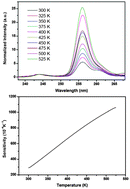A strategy for enhancing the sensitivity of optical thermometers in β-NaLuF4:Yb3+/Er3+ nanocrystals
Abstract
A strategy for enhancing the sensitivity of optical thermometers is developed herein by using non-thermally coupled levels of Er3+. Under the excitation of a 980 nm laser, the temperature dependence of 244 nm and 256 nm upconversion luminescences (UCLs) of Er3+ was studied. The corresponding 2I11/2 and 4D7/2 levels were confirmed to be non-thermally coupled levels. By using the fluorescence intensity ratio (FIR) technique and by investigating different thermal population behaviors of 2I11/2 and 4D7/2 levels, the optical temperature sensing performance based on the non-thermally coupled levels of Er3+ was fulfilled here for the first time. The obtained maximum sensor sensitivity is 0.106 K−1 at 525 K, which is much higher than those of all other RE3+ doped optical thermometers using the thermally coupled level-based FIR technique. This suggests that the use of the FIR from neighboring non-thermally coupled levels of RE3+ is a promising approach for enhancing the sensor sensitivity of optical thermometers.


 Please wait while we load your content...
Please wait while we load your content...